stop start DODGE SPRINTER 2004 1.G Owners Manual
[x] Cancel search | Manufacturer: DODGE, Model Year: 2004, Model line: SPRINTER, Model: DODGE SPRINTER 2004 1.GPages: 272, PDF Size: 22.71 MB
Page 26 of 272
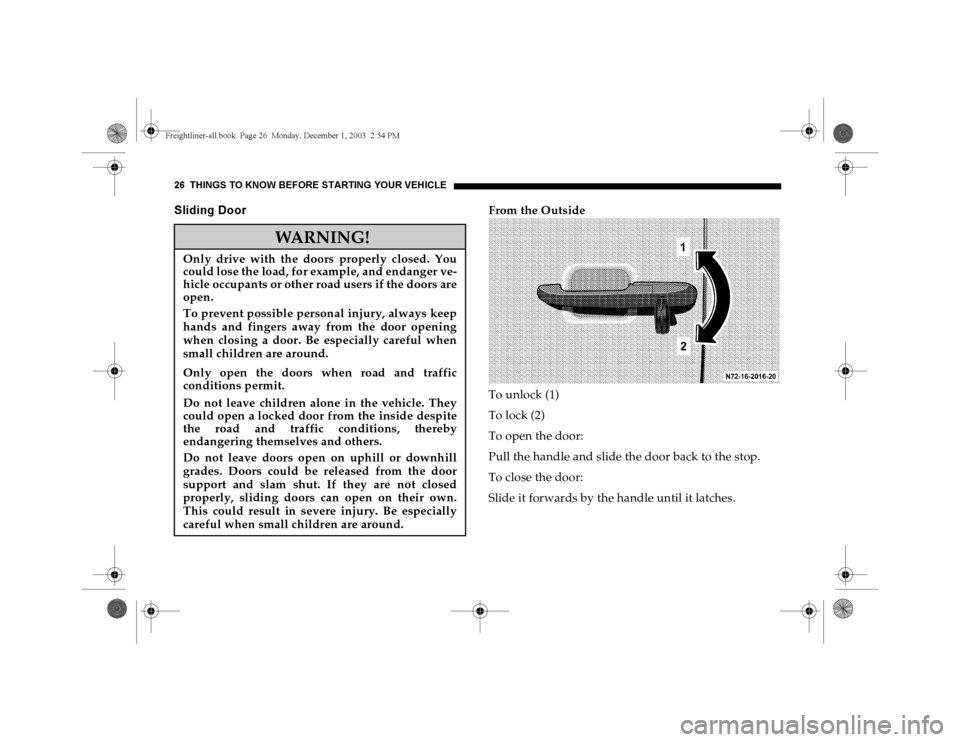
26 THINGS TO KNOW BEFORE STARTING YOUR VEH ICLESliding Door
From the Outside
To unlock (1)
To lock (2)
To open the door:
Pull the handle and slide the door back to the stop.
To close the door:
Slide it forwards by the handle until it latches.
WARNING!
Only drive with the doors properly closed. You
could lose the load, for example, and endanger ve-
hicle occupants or other road users if the doors are
open.
To prevent possible personal injury, always keep
hands and fingers away from the door opening
when closing a door. Be especially careful when
small children are around.
Only open the doors when road and traffic
conditions permit.
Do not leave children alone in the vehicle. They
could open a locked door from the inside despite
the road and traffic conditions, thereby
endangering themselves and others.
Do not leave doors open on uphill or downhill
grades. Doors could be released from the door
support and slam shut. If they are not closed
properly, sliding doors can open on their own.
This could result in severe injury. Be especially
careful when small children are around.
Freightliner-all.book Pag e 26 Monday , December 1, 2003 2:54 PM
Page 37 of 272
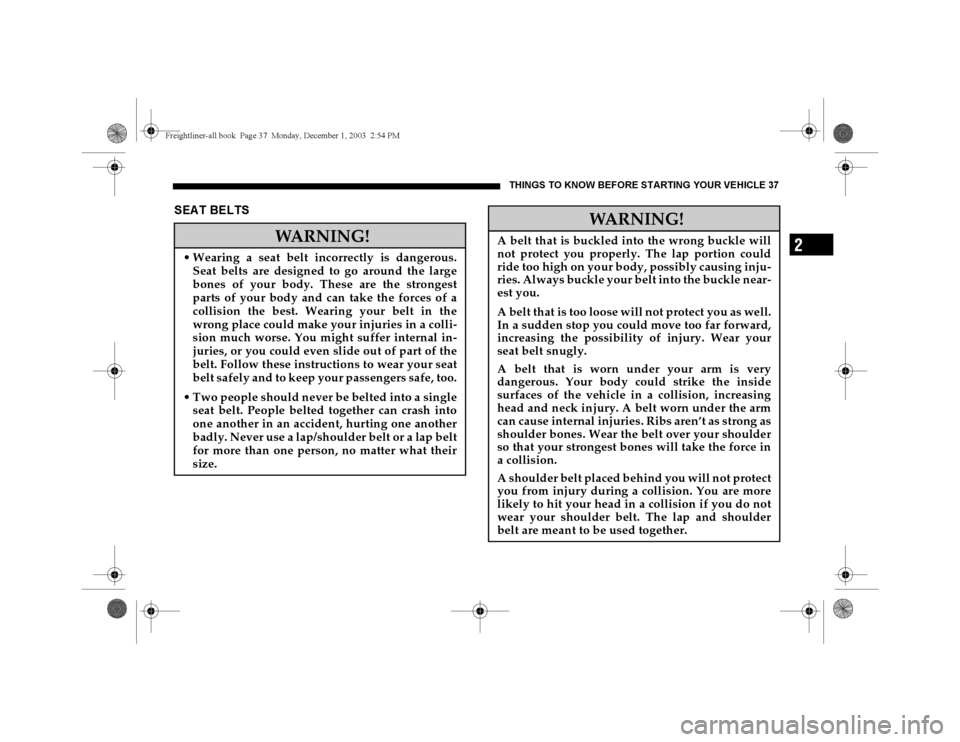
THINGS TO KNOW BEFORE STARTING YOUR VEHICLE 37
2
SEAT BELTS
WARNING!
Wearing a seat belt incorrectly is dangerous.
Seat belts are designed to go around the large
bones of your body. These are the strongest
parts of your body and can take the forces of a
collision the best. Wearing your belt in the
wrong place could make your injuries in a colli-
sion much worse. You might suffer internal in-
juries, or you could even slide out of part of the
belt. Follow these instructions to wear your seat
belt safely and to keep your passengers safe, too.
Two people should never be belted into a single
seat belt. People belted together can crash into
one another in an accident, hurting one another
badly. Never use a lap/shoulder belt or a lap belt
for more than one person, no matter what their
size.
WARNING!
A belt that is buckled into the wrong buckle will
not protect you properly. The lap portion could
ride too high on your body, possibly causing inju-
ries. Always buckle your belt into the buckle near-
est you.
A belt that is too loose will not protect you as well.
In a sudden stop you could move too far forward,
increasing the possibility of injury. Wear your
seat belt snugly.
A belt that is worn under your arm is very
dangerous. Your body could strike the inside
surfaces of the vehicle in a collision, increasing
head and neck injury. A belt worn under the arm
can cause internal injuries. Ribs aren’t as strong as
shoulder bones. Wear the belt over your shoulder
so that your strongest bones will take the force in
a collision.
A shoulder belt placed behind you will not protect
you from injury during a collision. You are more
likely to hit your head in a collision if you do not
wear your shoulder belt. The lap and shoulder
belt are meant to be used together.
Freightliner-all.book Pag e 37 Monday , December 1, 2003 2:54 PM
Page 38 of 272
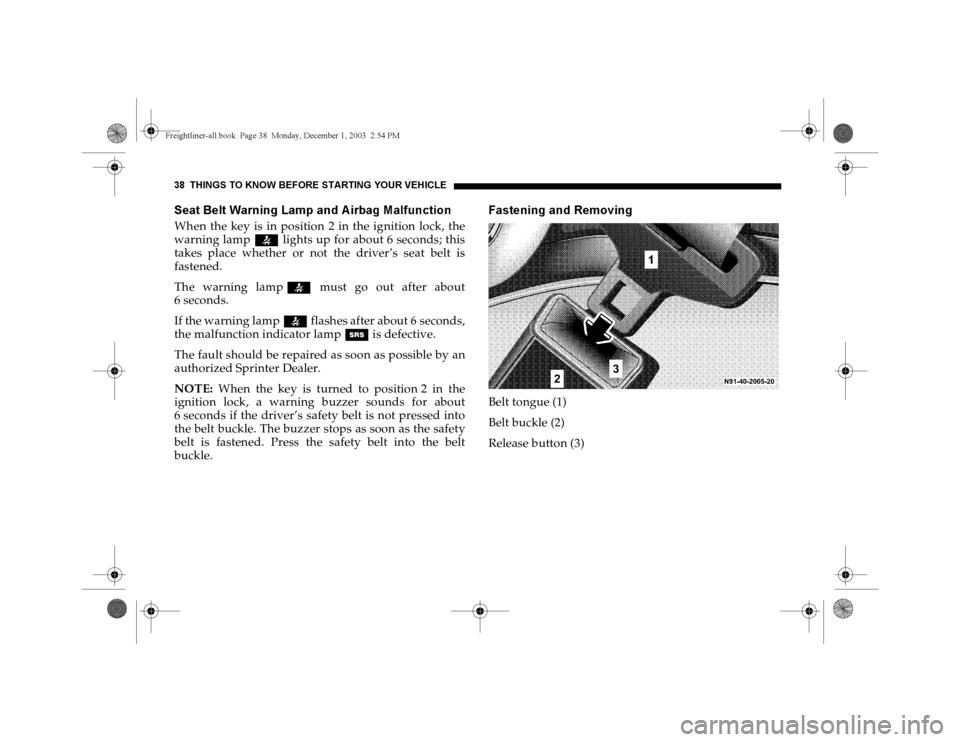
38 THINGS TO KNOW BEFORE STARTING YOUR VEH ICLESeat Belt Warning Lamp and A irbag MalfunctionWhen the key is in position 2 in the ignition lock, the
warning lamp < lights up for about 6 seconds; this
takes place whether or not the driver’s seat belt is
fastened.
The warning lamp< must go out after about
6seconds.
If the warning lamp< flashes after about 6 seconds,
the malfunction indicator lamp1 is defective.
The fault should be repaired as soon as possible by an
authorized Sprinter Dealer.
NOTE: When the key is turned to position 2 in the
ignition lock, a warning buzzer sounds for about
6 seconds if the driver’s safety belt is not pressed into
the belt buckle. The buzzer stops as soon as the safety
belt is fastened. Press the safety belt into the belt
buckle.
Fastening and RemovingBelt tongue (1)
Belt buckle (2)
Release button (3)
Freightliner-all.book Pag e 38 Monday , December 1, 2003 2:54 PM
Page 39 of 272
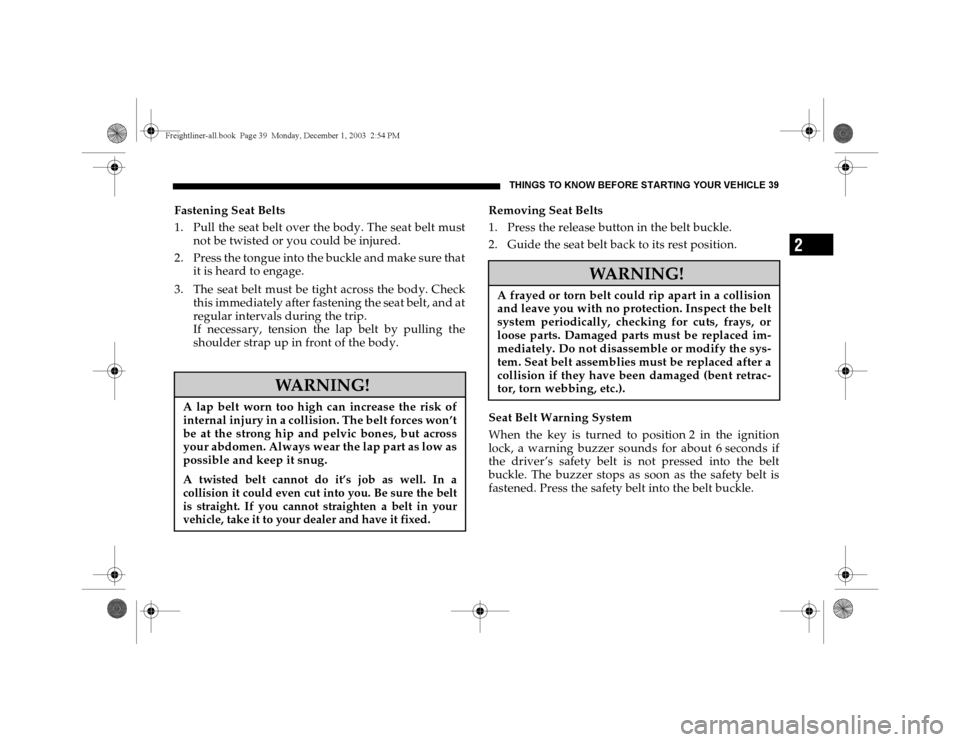
THINGS TO KNOW BEFORE STARTING YOUR VEHICLE 39
2
Fastening Seat Belts
1. Pull the seat belt over the body. The seat belt must
not be twisted or you could be injured.
2. Press the tongue into the buckle and make sure that
it is heard to engage.
3. The seat belt must be tight across the body. Check
this immediately after fastening the seat belt, and at
regular intervals during the trip.
If necessary, tension the lap belt by pulling the
shoulder strap up in front of the body.Removing Seat Belts
1. Press the release button in the belt buckle.
2. Guide the seat belt back to its rest position.
Seat Belt Warning System
When the key is turned to position 2 in the ignition
lock, a warning buzzer sounds for about 6 seconds if
the driver’s safety belt is not pressed into the belt
buckle. The buzzer stops as soon as the safety belt is
fastened. Press the safety belt into the belt buckle.
WARNING!
A lap belt worn too high can increase the risk of
internal injury in a collision. The belt forces won’t
be at the strong hip and pelvic bones, but across
your abdomen. Always wear the lap part as low as
possible and keep it snug.A twisted belt cannot do it’s job as well. In a
collision it could even cut into you. Be sure the belt
is straight. If you cannot straighten a belt in your
vehicle, take it to your dealer and have it fixed.
WARNING!
A frayed or torn belt could rip apart in a collision
and leave you with no protection. Inspect the belt
system periodically, checking for cuts, frays, or
loose parts. Damaged parts must be replaced im-
mediately. Do not disassemble or modify the sys-
tem. Seat belt assemblies must be replaced after a
collision if they have been damaged (bent retrac-
tor, torn webbing, etc.).
Freightliner-all.book Pag e 39 Monday , December 1, 2003 2:54 PM
Page 47 of 272
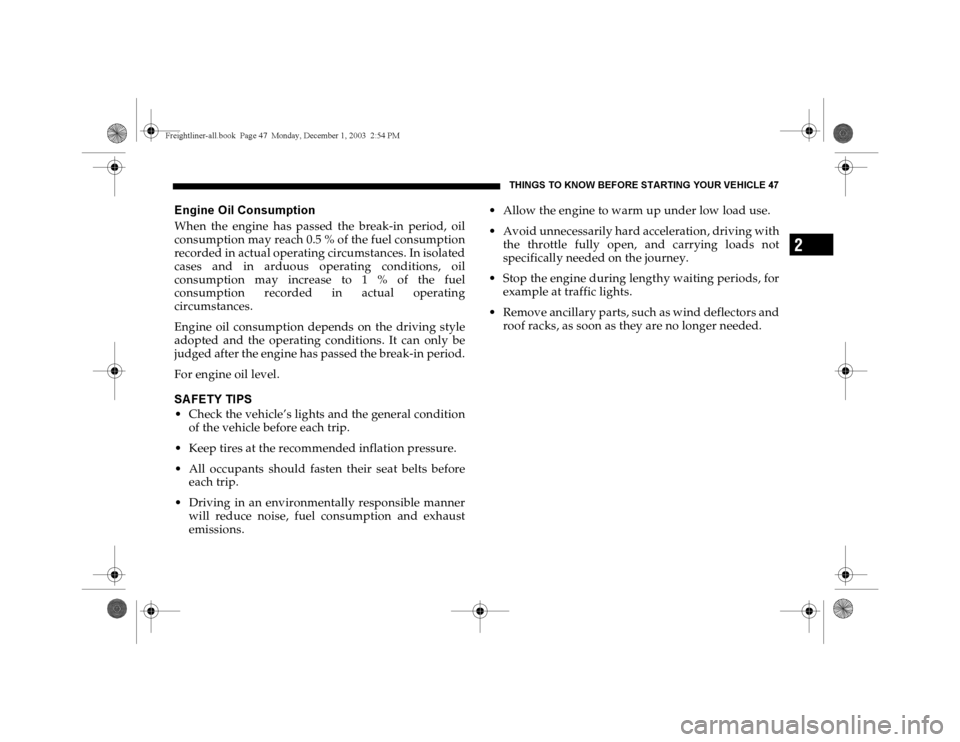
THINGS TO KNOW BEFORE STARTING YOUR VEHICLE 47
2
Engine Oil ConsumptionWhen the engine has passed the break-in period, oil
consumption may reach 0.5 % of the fuel consumption
recorded in actual operating circumstances. In isolated
cases and in arduous operating conditions, oil
consumption may increase to 1 % of the fuel
consumption recorded in actual operating
circumstances.
Engine oil consumption depends on the driving style
adopted and the operating conditions. It can only be
judged after the engine has passed the break-in period.
For engine oil level.SA FETY TI PS Check the vehicle’s lights and the general condition
of the vehicle before each trip.
Keep tires at the recommended inflation pressure.
All occupants should fasten their seat belts before
each trip.
Driving in an environmentally responsible manner
will reduce noise, fuel consumption and exhaust
emissions. Allow the engine to warm up under low load use.
Avoid unnecessarily hard acceleration, driving with
the throttle fully open, and carrying loads not
specifically needed on the journey.
Stop the engine during lengthy waiting periods, for
example at traffic lights.
Remove ancillary parts, such as wind deflectors and
roof racks, as soon as they are no longer needed.Freightliner-all.book Pag e 47 Monday , December 1, 2003 2:54 PM
Page 133 of 272
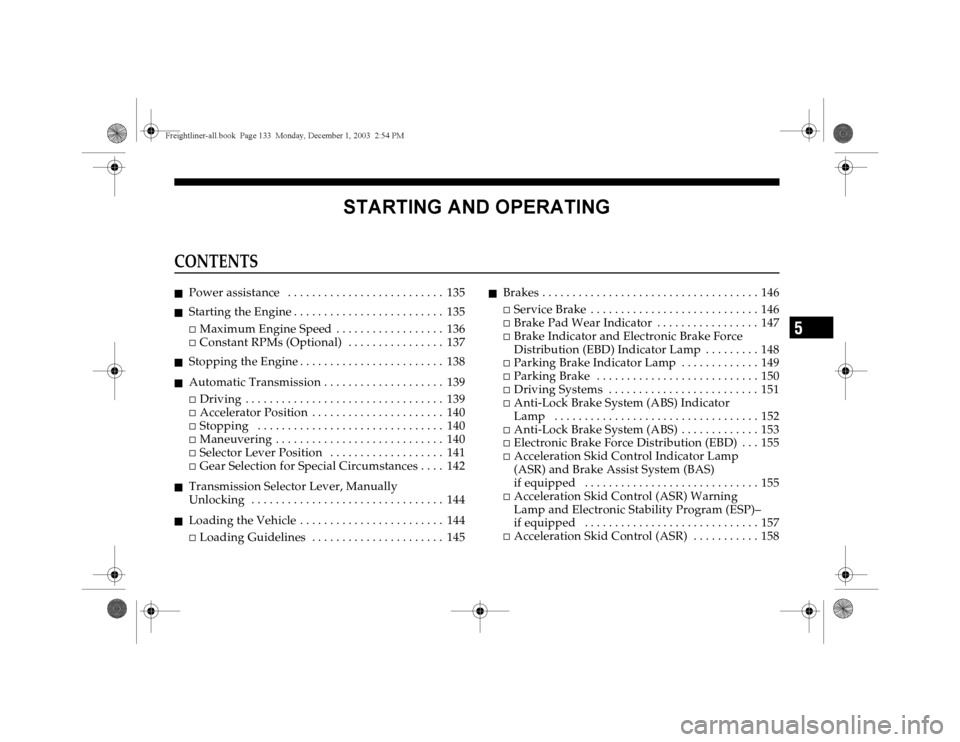
STARTING AND OPERATING
5
CONTENTS�
Power assistance . . . . . . . . . . . . . . . . . . . . . . . . . . 135
�
Starting the Engine . . . . . . . . . . . . . . . . . . . . . . . . . 135�Maximum Engine Speed . . . . . . . . . . . . . . . . . . 136�Constant RPMs (Optional) . . . . . . . . . . . . . . . . 137
�
Stopping the Engine . . . . . . . . . . . . . . . . . . . . . . . . 138
�
Automatic Transmission . . . . . . . . . . . . . . . . . . . . 139�Driving . . . . . . . . . . . . . . . . . . . . . . . . . . . . . . . . . 139�Accelerator Position . . . . . . . . . . . . . . . . . . . . . . 140�Stopping . . . . . . . . . . . . . . . . . . . . . . . . . . . . . . . 140�Maneuvering . . . . . . . . . . . . . . . . . . . . . . . . . . . . 140�Selector Lever Position . . . . . . . . . . . . . . . . . . . 141�Gear Selection for Special Circumstances . . . . 142
�
Transmission Selector Lever, Manually
Unlocking . . . . . . . . . . . . . . . . . . . . . . . . . . . . . . . . 144
�
Loading the Vehicle . . . . . . . . . . . . . . . . . . . . . . . . 144�Loading Guidelines . . . . . . . . . . . . . . . . . . . . . . 145
�
Brakes . . . . . . . . . . . . . . . . . . . . . . . . . . . . . . . . . . . . 146�Service Brake . . . . . . . . . . . . . . . . . . . . . . . . . . . . 146�Brake Pad Wear Indicator . . . . . . . . . . . . . . . . . 147�Brake Indicator and Electronic Brake Force
Distribution (EBD) Indicator Lamp . . . . . . . . . 148�Parking Brake Indicator Lamp . . . . . . . . . . . . . 149�Parking Brake . . . . . . . . . . . . . . . . . . . . . . . . . . . 150�Driving Systems . . . . . . . . . . . . . . . . . . . . . . . . . 151�Anti-Lock Brake System (ABS) Indicator
Lamp . . . . . . . . . . . . . . . . . . . . . . . . . . . . . . . . . . 152�Anti-Lock Brake System (ABS) . . . . . . . . . . . . . 153�Electronic Brake Force Distribution (EBD) . . . 155�Acceleration Skid Control Indicator Lamp
(ASR) and Brake Assist System (BAS)
if equipped . . . . . . . . . . . . . . . . . . . . . . . . . . . . . 155�Acceleration Skid Control (ASR) Warning
Lamp and Electronic Stability Program (ESP)–
if equipped . . . . . . . . . . . . . . . . . . . . . . . . . . . . . 157�Acceleration Skid Control (ASR) . . . . . . . . . . . 158
Freightliner-all.book Pag e 133 Monday, December 1, 2003 2:54 PM
Page 136 of 272
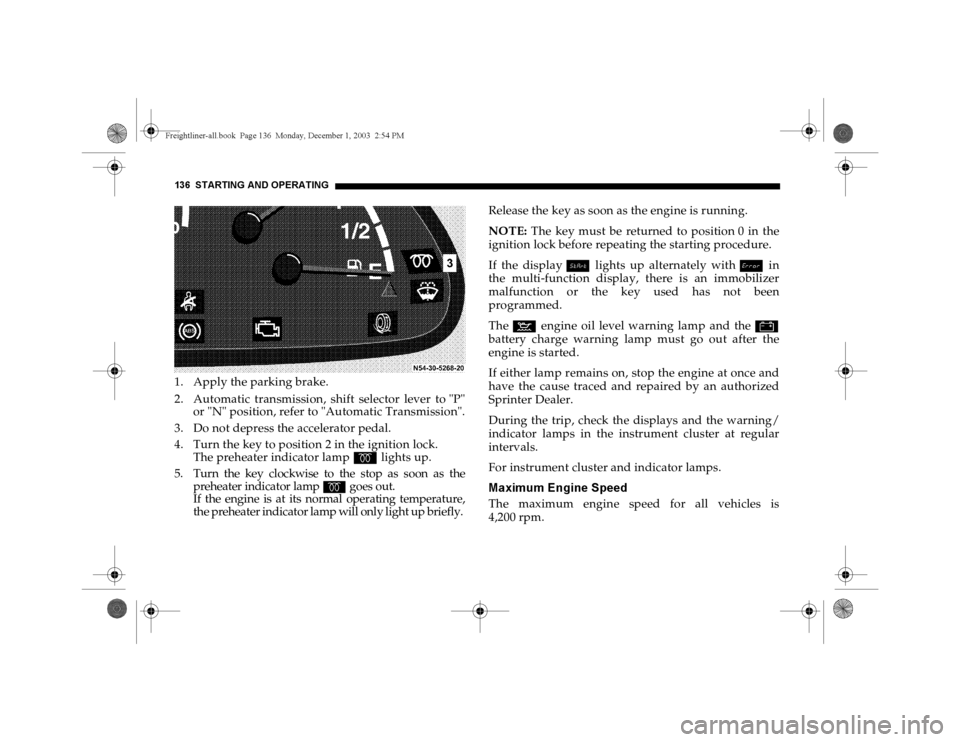
136 STARTING AND OPERATING1. Apply the parking brake.
2. Automatic transmission, shift selector lever to "P"
or "N" position, refer to "Automatic Transmission".
3. Do not depress the accelerator pedal.
4. Turn the key to position 2 in the ignition lock.
The preheater indicator lampq lights up.5. Turn the key clockwise to the stop as soon as the
preheater indicator lamp
q
goes out.
If the engine is at its normal operating temperature,
the preheater indicator lamp will only light up briefly.
Release the key as soon as the engine is running.
NOTE: The key must be returned to position 0 in the
ignition lock before repeating the starting procedure.
If the displayÁ lights up alternately withî in
the multi-function display, there is an immobilizer
malfunction or the key used has not been
programmed.
The: engine oil level warning lamp and the#
battery charge warning lamp must go out after the
engine is started.
If either lamp remains on, stop the engine at once and
have the cause traced and repaired by an authorized
Sprinter Dealer.
During the trip, check the displays and the warning/
indicator lamps in the instrument cluster at regular
intervals.
For instrument cluster and indicator lamps.Maximum Engine SpeedThe maximum engine speed for all vehicles is
4,200 rpm.
Freightliner-all.book Pag e 136 Monday, December 1, 2003 2:54 PM
Page 138 of 272
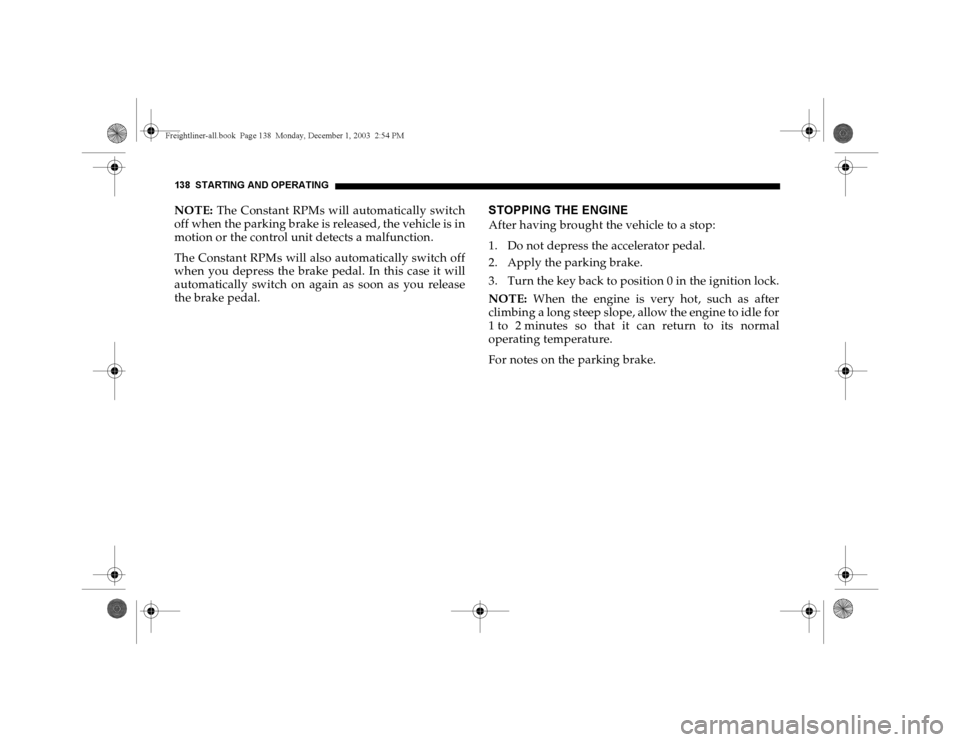
138 STARTING AND OPERATINGNOTE: The Constant RPMs will automatically switch
off when the parking brake is released, the vehicle is in
motion or the control unit detects a malfunction.
The Constant RPMs will also automatically switch off
when you depress the brake pedal. In this case it will
automatically switch on again as soon as you release
the brake pedal.
STOPPING THE ENGINEAfter having brought the vehicle to a stop:
1. Do not depress the accelerator pedal.
2. Apply the parking brake.
3. Turn the key back to position 0 in the ignition lock.
NOTE: When the engine is very hot, such as after
climbing a long steep slope, allow the engine to idle for
1 to 2 minutes so that it can return to its normal
operating temperature.
For notes on the parking brake.
Freightliner-all.book Pag e 138 Monday, December 1, 2003 2:54 PM
Page 140 of 272
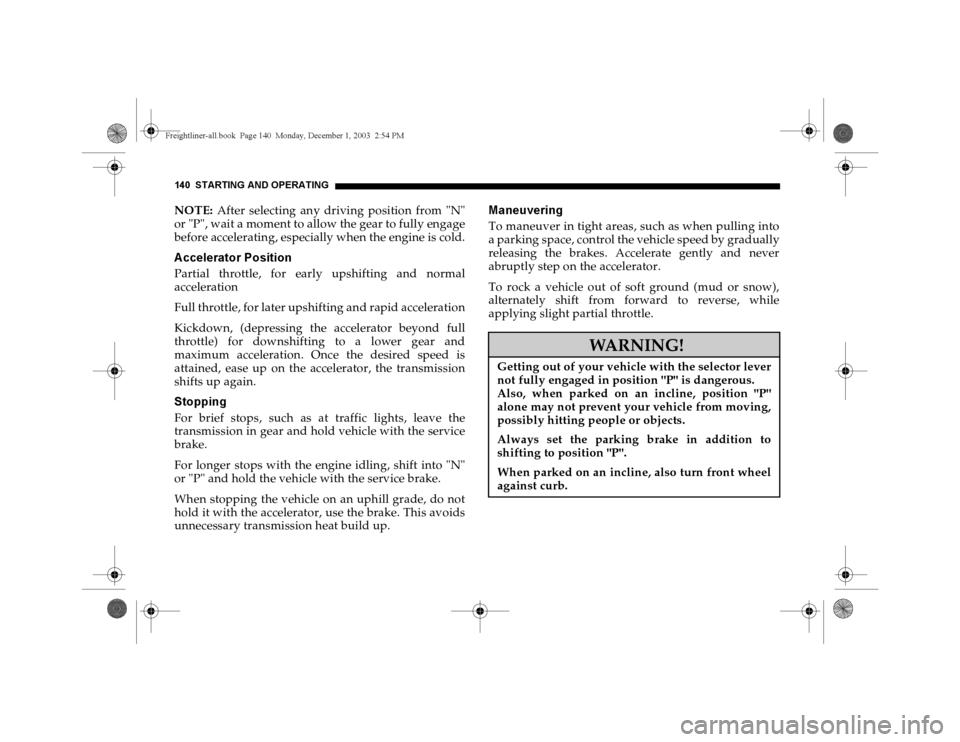
140 STARTING AND OPERATINGNOTE: After selecting any driving position from "N"
or "P", wait a moment to allow the gear to fully engage
before accelerating, especially when the engine is cold.A ccelerator PositionPartial throttle, for early upshifting and normal
acceleration
Full throttle, for later upshifting and rapid acceleration
Kickdown, (depressing the accelerator beyond full
throttle) for downshifting to a lower gear and
maximum acceleration. Once the desired speed is
attained, ease up on the accelerator, the transmission
shifts up again.StoppingFor brief stops, such as at traffic lights, leave the
transmission in gear and hold vehicle with the service
brake.
For longer stops with the engine idling, shift into "N"
or "P" and hold the vehicle with the service brake.
When stopping the vehicle on an uphill grade, do not
hold it with the accelerator, use the brake. This avoids
unnecessary transmission heat build up.
ManeuveringTo maneuver in tight areas, such as when pulling into
a parking space, control the vehicle speed by gradually
releasing the brakes. Accelerate gently and never
abruptly step on the accelerator.
To rock a vehicle out of soft ground (mud or snow),
alternately shift from forward to reverse, while
applying slight partial throttle.
WARNING!
Getting out of your vehicle with the selector lever
not fully engaged in position "P" is dangerous.
Also, when parked on an incline, position "P"
alone may not prevent your vehicle from moving,
possibly hitting people or objects.
Always set the parking brake in addition to
shifting to position "P".
When parked on an incline, also turn front wheel
against curb.
Freightliner-all.book Pag e 140 Monday, December 1, 2003 2:54 PM
Page 141 of 272
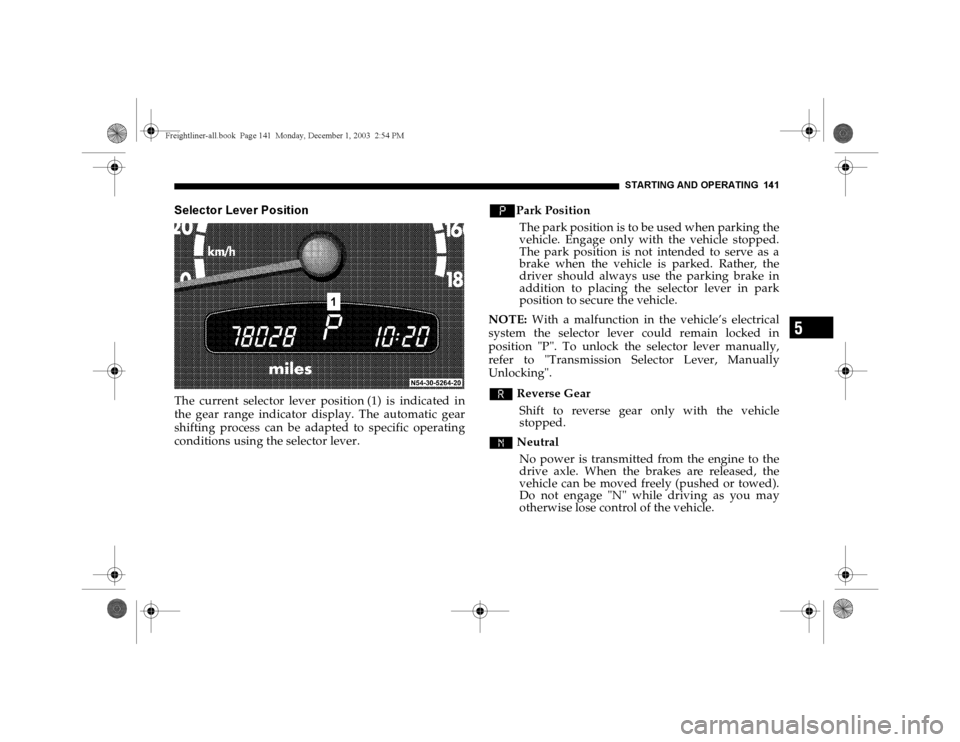
STARTING AND OPERATING 141
5
Selector Lever PositionThe current selector lever position (1) is indicated in
the gear range indicator display. The automatic gear
shifting process can be adapted to specific operating
conditions using the selector lever.
v
Park Position
The park position is to be used when parking the
vehicle. Engage only with the vehicle stopped.
The park position is not intended to serve as a
brake when the vehicle is parked. Rather, the
driver should always use the parking brake in
addition to placing the selector lever in park
position to secure the vehicle.
NOTE: With a malfunction in the vehicle’s electrical
system the selector lever could remain locked in
position "P". To unlock the selector lever manually,
refer to "Transmission Selector Lever, Manually
Unlocking".
t Reverse Gear
Shift to reverse gear only with the vehicle
stopped.
s Neutral
No power is transmitted from the engine to the
drive axle. When the brakes are released, the
vehicle can be moved freely (pushed or towed).
Do not engage "N" while driving as you may
otherwise lose control of the vehicle.
Freightliner-all.book Pag e 141 Monday, December 1, 2003 2:54 PM